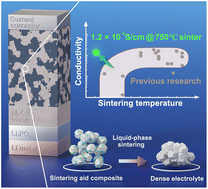Impact of intentional composition tuning on the sintering properties of Ca–Bi co-doped Li7La3Zr2O12 for co-fired solid-state batteries†
Abstract
Li7La3Zr2O12 (LLZ) is a promising candidate electrolyte for co-fired all-solid-state Li-ion batteries. However, its application is hindered by the reaction between LLZ and electrode materials during high-temperature sintering. To reduce the sintering temperature, herein Li–Bi–O oxide is added as a low-melting-point material into Ca–Bi co-doped LLZ (LLZ-CaBi). Nanocomposites of Li6.5(La2.92−xCa0.08)(Zr1.42Bi0.58)O12 and Li–Bi–O are fabricated. Here, Li–Bi–O is formed in the particles by intentional composition tuning using a lower amount of La than the stoichiometric composition. Direct observation of the nanocomposite reveals Li–Ca–Bi–O, Ca–Bi–O, and Li2CO3 in mother LLZ–CaBi particles. Some properties improve as x increases, and after sintering at 750 °C the highest relative density of 94% and ionic conductivity of 1.2 × 10−3 S cm−1 are achieved at x = 0.13. Li, Ca, and Bi are dissolved in the liquid phase and re-precipitated to promote further densification. The dependence of ionic conductivity on x is well explained by the relative density and alleviation of bottlenecks in the Li-ion diffusion path. Moreover, the developed LLZ–CaBi could be co-fired with LiCoO2, and the co-fired half-cell successfully operates as an all-solid-state battery at room temperature. Thus, the composite of LLZ–CaBi with Li–Bi–O can be applied as a catholyte in solid-state batteries.

- This article is part of the themed collection: 2023 Journal of Materials Chemistry A HOT Papers


 Please wait while we load your content...
Please wait while we load your content...